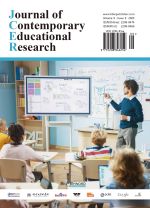Exploration of the Artistic Expression Characteristics and AIGC Technology Application Boundaries of the Animated Short Film Glimmer
Abstract
This paper focuses on the original animated short film Glimmer, conducting an in-depth exploration of its artistic expression characteristics and the application boundaries of AIGC (Artificial Intelligence Generated Content) technology. Presented in a sketch style, the film creates unique visual effects and emotional atmospheres through techniques such as lines and light-dark contrast, demonstrating the distinctive charm of the sketch style in animation creation. Meanwhile, the paper reflects on the application of AIGC technology in animation creation, pointing out its optimization potential in aspects such as character expressions, scene design, storyboard scripts, and creative sound effects. The study emphasizes that although AIGC technology brings opportunities, issues related to originality and dependence on the technology (by creators) also need attention. This paper aims to provide theoretical references and practical guidance for animation education and creation, promote the integrated development of animation art and technology, and drive innovation and progress in the field of animation creation.
References
Chen Z, 2024, A Brief Discussion on the Impact of Radio and Television Institutions Entering Micro-Short Dramas. International Brand Observation, 2024(14): 73–75.
Wang L, 2014, A Brief Discussion on the Presentation of “Emotion” in Experimental Animated Short Films. Contemporary Cinema, 2014(3): 192–194.
Meng S, 2014, The Application of Line Art in Sketching. Grand Stage, 2014(6): 23–24.
Zou L, 2014, Experiencing the Rhythm of “Light and Shadow”: An Exploration of the Teaching of Imagery Expression in Design Sketching. Decoration, 2014(4): 110–111.
Feng F, 1999, From “Concreteness” to “Abstraction”: Between Sketching and Design. Art Garden, 1999(6): 46–47.
Guo Z, 2002, Thoughts on Integrating Abstract Thinking Teaching into Design Sketching. Decoration, 2002(5): 59.
Yang X, 2024, Research on the Application of Digital Technology and AIGC in Promoting the Radio and Television Industry. China Electronic Business Status, 2024(13): 78–80.
Rombach R, Blattmann A, Lorenz D, et al., 2022, High-Resolution Image Synthesis with Latent Diffusion Models. Proceedings of the IEEE/CVF Conference on Computer Vision and Pattern Recognition, 10684–10695.
Podell D, English Z, Lacey K, et al., 2025, SDXL: Improving Latent Diffusion Models for High-Resolution Image Synthesis. arXiv preprint, 2307: 01952
Tsydilo I, Sena C, 2023, Artificial Intelligence as a Methodological Innovation in the Training of Future Designers: Midjourney Tools. Information Technologies and Learning Tools, 97(5): 203.
Flux AI, 2025, Official Website of Flux AI, visited on 2025-04-17, https://flux-ai.io/cn/.
Kingma D, Welling M, 2025, Auto-Encoding Variational Bayes, visited on 2025-04-17, https://arxiv.org/abs/1312.6114
Mildenhall B, Srinivasan P, Tanck M, et al., 2025, NeRF: Representing Scenes as Neural Radiance Fields for View Synthesis. Communications of the ACM, 65(1): 99–106.
Kerbl B, Koponen D, Laine S, et al., 2025, 3D Gaussian Splatting for Real-Time Radiance Field Rendering. ACM Trans Graph, 42(4): 139
Huang D, Tang Y, Huang Q, et al., 2025, Innovative Application and Practice of AIGC Technology in Intelligent Generation of Film and Television Dynamic Storyboards. Modern Cinema Technology, 2025(5): 21–29.

